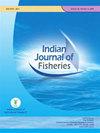大豆卵磷脂对高渗胁迫下印度斑节对虾生长和体成分的影响
IF 0.3
4区 农林科学
Q4 FISHERIES
引用次数: 0
摘要
本试验旨在研究饲料中添加大豆卵磷脂(磷脂酰胆碱)对高渗胁迫条件下(40‰)室内养殖的单对虾生长性能的影响。分别以1%、1.5%、2%和2.5%的添加率配制DL-1(对照)、DL-1.5、DL-2和DL-2.5 4种试验饲粮。结果表明:日生长系数(DGC)显著(p0.05),胆固醇(p < 0.05)无显著影响。除了饲料中C16:0和C18:2c脂肪酸含量较高(p2.5%)外,大豆卵磷脂的添加水平对单叶假单虾的脂肪酸组成没有显著影响。关键词:胴体组成,高渗胁迫,单对虾,磷脂,盐度,大豆卵磷脂本文章由计算机程序翻译,如有差异,请以英文原文为准。
Effect of dietary soy-lecithin on growth and body composition of Indian black tiger shrimp Penaeus monodon (Fabricius, 1798) reared under hyperosmotic stress condition
Sixty days feeding trial was conducted to study the effect of dietary soy-lecithin (phosphatidylcholine) as a source ofphospholipids on the growth performance of Penaeus monodon (Fabricius, 1798) reared at hyperosmotic stress conditions(40‰) in indoor tanks. Four experimental diets viz., DL-1 (Control), DL-1.5, DL-2 and DL-2.5 were formulated by includingsoy-lecithin at the rate of 1, 1.5, 2 and 2.5%, respectively. The results revealed that the daily growth coefficient (DGC)significantly (p<0.05) increased from 1.44 to 1.67% day-1 when the inclusion levels were increased from 1 to 2.5%. Therelative growth rate (RGR) was significantly (p<0.05) high in the groups fed on DL-2 and DL-2.5 diets than in the groupsfed other diets (DL-1 and DL-1.5). Compared to DL-1, all the other diets (DL-1.5, DL-2 and DL-2.5) had increased DGCby 7.81, 11.06 and 15.89% and decreased feed conversion ratio (FCR) by 8.70, 8.83 and 9.56%, respectively. The dietarytreatments had no significant difference in survival (75.56-82.22%) and carcass composition except body lipid, which wassignificantly (p<0.05) high (3.66%) in DL-2 and DL-2.5 fed groups compared to DL-1 and DL-1.5 (3.25-3.42%). Carcassphospholipids increased (p<0.05) from 61.96 to 69.69% with increasing dietary soy-lecithin levels, while triacylglycerides(p>0.05) and cholesterol (p>0.05) were not affected. The inclusion levels of soy-lecithin had no significant influence on thefatty acid composition of P. monodon except for C16:0 and C18:2c, which were high (p<0.05) in the groups fed DL-2 andDL-2.5 diets. Results concluded that soy-lecithin as a source of phospholipids can be more effective at hyperosmotic stressconditions and could be included at >2.5% in the diet of P. monodon.
Keywords: Carcass composition, Hyperosmotic stress, Penaeus monodon, Phospholipids, Salinity, Soy-lecithin
求助全文
通过发布文献求助,成功后即可免费获取论文全文。
去求助
来源期刊

Indian Journal of Fisheries
FISHERIES-
CiteScore
0.90
自引率
20.00%
发文量
0
审稿时长
6-12 weeks
期刊介绍:
Indian Journal of Fisheries is published quarterly by the Indian Council of Agricultural Research (ICAR), New Delhi. Original contributions in the field of Fish and fisheries science are considered for publication in the Journal. The material submitted must be unpublished and not under consideration for publication elsewhere.
Papers based on research which kills or damages any species, regarded as thratened/ endangered by IUCN crieteria or is as such listed in the Red Data Book appropriate to the geographic area concerned, will not be accepted by the Journal, unless the work has clear conservation objectives.
 求助内容:
求助内容: 应助结果提醒方式:
应助结果提醒方式:


